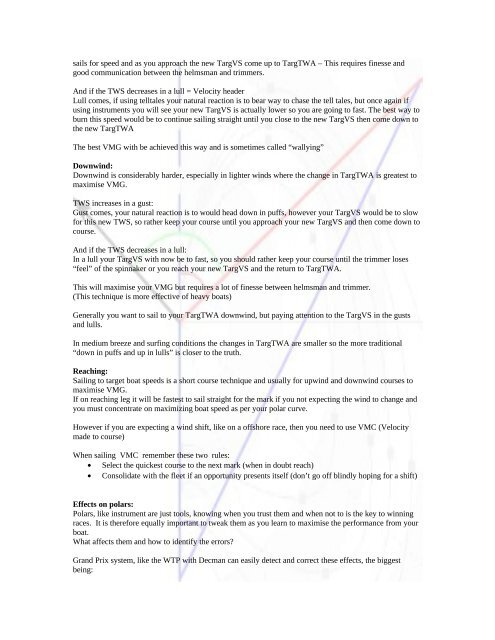Race boat instruments â understanding it all - L-36 Fleet
Race boat instruments â understanding it all - L-36 Fleet
Race boat instruments â understanding it all - L-36 Fleet
Create successful ePaper yourself
Turn your PDF publications into a flip-book with our unique Google optimized e-Paper software.
sails for speed and as you approach the new TargVS come up to TargTWA – This requires finesse andgood communication between the helmsman and trimmers.And if the TWS decreases in a lull = Veloc<strong>it</strong>y headerLull comes, if using telltales your natural reaction is to bear way to chase the tell tales, but once again ifusing <strong>instruments</strong> you will see your new TargVS is actu<strong>all</strong>y lower so you are going to fast. The best way toburn this speed would be to continue sailing straight until you close to the new TargVS then come down tothe new TargTWAThe best VMG w<strong>it</strong>h be achieved this way and is sometimes c<strong>all</strong>ed “w<strong>all</strong>ying”Downwind:Downwind is considerably harder, especi<strong>all</strong>y in lighter winds where the change in TargTWA is greatest tomaximise VMG.TWS increases in a gust:Gust comes, your natural reaction is to would head down in puffs, however your TargVS would be to slowfor this new TWS, so rather keep your course until you approach your new TargVS and then come down tocourse.And if the TWS decreases in a lull:In a lull your TargVS w<strong>it</strong>h now be to fast, so you should rather keep your course until the trimmer loses“feel” of the spinnaker or you reach your new TargVS and the return to TargTWA.This will maximise your VMG but requires a lot of finesse between helmsman and trimmer.(This technique is more effective of heavy <strong>boat</strong>s)Gener<strong>all</strong>y you want to sail to your TargTWA downwind, but paying attention to the TargVS in the gustsand lulls.In medium breeze and surfing cond<strong>it</strong>ions the changes in TargTWA are sm<strong>all</strong>er so the more trad<strong>it</strong>ional“down in puffs and up in lulls” is closer to the truth.Reaching:Sailing to target <strong>boat</strong> speeds is a short course technique and usu<strong>all</strong>y for upwind and downwind courses tomaximise VMG.If on reaching leg <strong>it</strong> will be fastest to sail straight for the mark if you not expecting the wind to change andyou must concentrate on maximizing <strong>boat</strong> speed as per your polar curve.However if you are expecting a wind shift, like on a offshore race, then you need to use VMC (Veloc<strong>it</strong>ymade to course)When sailing VMC remember these two rules:• Select the quickest course to the next mark (when in doubt reach)• Consolidate w<strong>it</strong>h the fleet if an opportun<strong>it</strong>y presents <strong>it</strong>self (don’t go off blindly hoping for a shift)Effects on polars:Polars, like instrument are just tools, knowing when you trust them and when not to is the key to winningraces. It is therefore equ<strong>all</strong>y important to tweak them as you learn to maximise the performance from your<strong>boat</strong>.What affects them and how to identify the errors?Grand Prix system, like the WTP w<strong>it</strong>h Decman can easily detect and correct these effects, the biggestbeing:
















